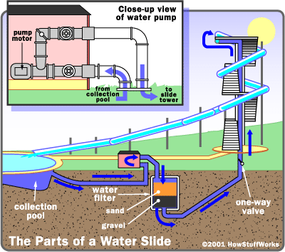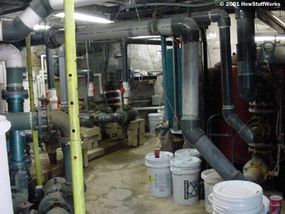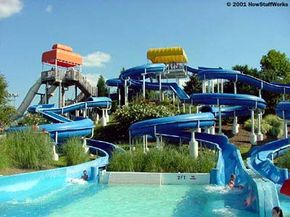Putting the Water in Waterslides
In order to zip down the slide, you need a constant stream of water to reduce friction between you and the fiberglass surface. To maintain this stream, the water park has to get a supply of water to the top of the slide. Most waterslides do this with a pump, housed in a building near the base of the slide. In the standard design, the pump motor turns a drive shaft, which is attached to a propeller. The spinning propeller drives water forward, in the same way an airplane propeller moves air particles.
The pump draws water from a collection sump, typically the pool at the base of the slide, and pushes it up through a narrow pipe to the top of the slide. In this way, the water running down the slide is constantly recycled. In some parks, the water is cycled through several connected pools before it is pumped back up to the top of a slide.
Advertisement

In a typical setup, the water line has a check valve, also called a one-way valve, positioned between the pump and the top of the slide. Water can only flow upward through this valve. This makes things easier for the water park facilitators. When they shut off the pump at night, all of the water from the check valve to the top of the slide sits in the pipe. When they turn the pump on again in the morning, they don't have to wait for the pipes to refill; the water starts flowing immediately.
To keep everything sanitary, the water in the collection pool is also pumped through a strainer and a filter system. The typical filter is a large container filled with sand, which sits on top of a layer of gravel. Water is pumped from the top of the container to the bottom, through the sand and gravel layers. The sharp edges of the fine sand particles trap the bits of dirt in the passing water.

At night, the park managers reverse the flow of water through the filter. As water moves up through the sand, it dislodges the bits of dirt, cleaning the filter. This backwash is pumped out to the sewer line. In a typical collecting pool, all of the water is passed through the filter several times a day. Any swimming pool is constantly losing water — through filtering, evaporation and people carrying water away in their swimsuits. To keep the pools filled, the park has to pump in more water, either from a well or the city line.
Waterslides continue to advance at a breakneck pace. One of the most interesting advancements in waterslides is "water coasters." These newer designs actually use water to push you uphill. In these rides, the pump system drives high-pressure water to several points along the slide. When the slide dips, the water jets propel you up the next hill. With this element, designers can make slides that carry you in a complete circle, like a roller coaster. It's really amazing what you can do with only water, plastic, fiberglass and gravity.
Related HowStuffWorks Links
- 10 Classic Amusement Park Rides
- 12 of the World's Greatest Roller Coasters
- How Roller Coasters Work
- How Wave Pools Work
- How Water Blasters Work
- How Rip Currents Work
- How Water Towers Work
- How Force, Power, Torque and Energy Work
- How does gravity work?
- What makes a roller coaster a 'mega coaster'?
- What makes you dizzy when you spin around?
- What is the "heat index" that the weatherperson talks about during the summer?
